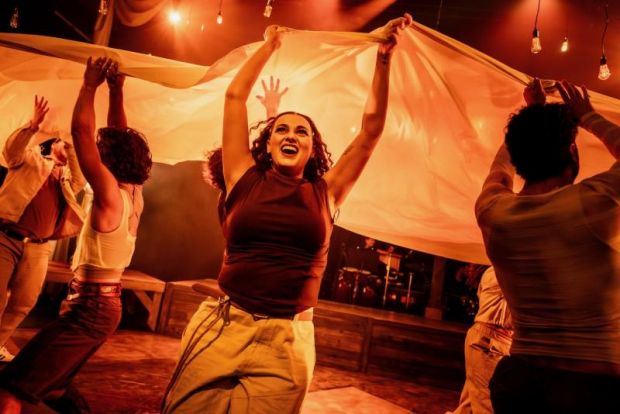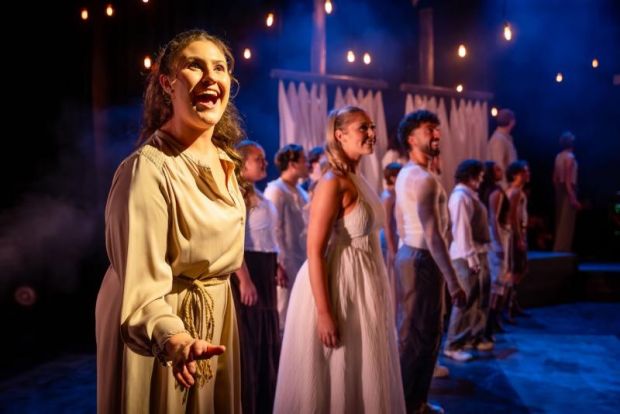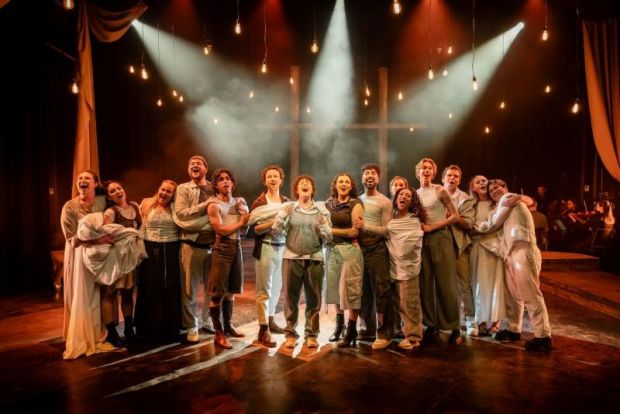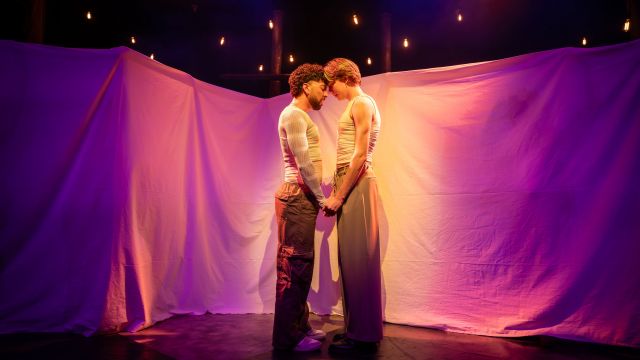Songs for a New World
What makes this version of Songs for a New World special, so full of energy and sheer entertainment is the perfect coordination and collaboration of everything and everybody.
Without a single exception, there’s the dazzling cast of fifteen on stage; Lauren McKinnon’s fluid, pacey direction; Benjamin Curé’s spirited choreography in a show not even intended to have choreography; the band, under Mark Bradly, segueing from one musical style to another, without once fighting the singing; Sidney Younger’s subtle lighting design that guides and shapes our attention and emotions; Harry Gill’s ingenious set of dais and movable platforms; Thanu Moultan’s unifying sound design; and much credit must go to producer Benjamin Samuel for bringing all this talent together.

Songs for a New World has no plot, no story, and is held together by the sketchiest of themes: turning points in the characters’ lives and keeping on keeping on despite the odds. At its end, there’s that characteristic American optimism. Originally conceived in 1995, Jason Robert Brown and Daisy Prince picked nineteen songs from other shows and for other venues and put together this show that’s somewhere between a song cycle and music theatre. The musical styles vary among your big Broadway show tunes music theatre, pop, gospel, parody and jazz. Jason Robert Brown’s facility across styles and genres must rival, say, Kander and Ebb.
The style goes with the song, each of which is sung by a clearly defined character whom we understand perfectly. There are narratives, there are predicaments and there are pleas. There is humour, there is irony, there is heartfelt emotion. But there is no narrative, continuity or character development. And yet what is marvellous about this production – originally mounted in 2023 – is the way the songs meld into a whole that sweeps us along with it.

Originally conceived for just four performers, this Soundworks production has fifteen, but what the cast does with the songs is much cleverer and more engaging than just dividing them up. There are solos, certainly – such as ‘Just One Step’, ‘She Cries’, ‘Christmas Lullaby’, and the superbly sung ‘Flying Home’- but many songs are shared – so to speak – and enhanced by movement and dance.
A song might begin as a solo, but then it’s ‘passed’ to another performer and becomes a duet, or a trio. Or a song is a duet or a trio all along. Or it’s a song by the whole company. There are no gender divisions – so songs written for one gender are sung by another. It’s not at all gimmicky: it works. ‘I’d Give It All for You’ in Act II has former lovers reunite. ‘Stars and Moon’ in Act I – a song of regret for marrying the wrong man - is a trio and so adds another layer to the song: the three women exchange knowing but supportive looks - more than one woman married the wrong man. ‘Surabaya-Santa’ in Act II – a clever parody of Kurt Weill’s ‘Surabaya Johnny’ is also a trio – and funny: instead of a lament, it’s a feisty protest.

I’m told that the cast themselves originally worked out all these transitions, overlaps and the apportioning of who gets which song. They have done a fantastic job. It would be unfair to pick out individual cast members for praise and commendation. As noted, they are all wonderful – as singers, dancers and actors. But the camaraderie, collaboration and support amongst them is palpable. And there is a feeling – something again that holds it all together – that this cast does not say to the audience, ‘Now it’s her turn...’ Or ‘Now it’s his turn.’ With this version of Songs for a New World, the whole production says to the audience, ‘We – all of us together – offer you this show.’ And we take it gratefully. The run is much too short. Get along quick.
Michael Brindley
Photographer: Matthew Chen
Subscribe to our E-Newsletter, buy our latest print edition or find a Performing Arts book at Book Nook.

